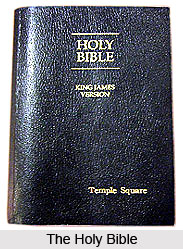 The Bible refers to the sacred writings of Judaism and Christianity. Bible has been passed down and read by the Christians all over the world for many generations together. Some believe it to be a fantastic historical treasure, others believe it to be a book to live by and rest as a simply fantastic story woven over time. There are those who also believe it to be the "Word of God" given to mankind for comfort and guidance. They believe that God speaks to man through the Bible and gives them wisdom, knowledge and guidance in their daily lives. Many people who identify themselves as Christians or Jews regard the Bible to be inspired by God. All Christians accept the authority of the Bible. Much of the moral teachings of it are aimed at everyday life in this world.
The Bible refers to the sacred writings of Judaism and Christianity. Bible has been passed down and read by the Christians all over the world for many generations together. Some believe it to be a fantastic historical treasure, others believe it to be a book to live by and rest as a simply fantastic story woven over time. There are those who also believe it to be the "Word of God" given to mankind for comfort and guidance. They believe that God speaks to man through the Bible and gives them wisdom, knowledge and guidance in their daily lives. Many people who identify themselves as Christians or Jews regard the Bible to be inspired by God. All Christians accept the authority of the Bible. Much of the moral teachings of it are aimed at everyday life in this world.
Compilation of The Bible
The Bible as used by the majority of Christians all over the world includes the Hebrew Scripture. It is divided into two main parts;
1. The Old Testament and
2. The New Testament.
Along with the Jews, the Protestants, etc take 39 books to be the Old Testament whereas the Catholic group takes 46 books as constituting the Old Testament and 27 books to constitute the New Testament.
The Old Testament: The Old Testament constitutes the first major part of the Bible used by Christians all over the world. The main divisions of this book are law, history, poetry and prophecy. The Old Testament was written before the birth of Jesus that subsequently became the subject of the New Testament. The Old Testament was composed from 2nd Century BC to 5th Century BC. The Old Testament was written originally in Hebrew language.
The New Testament: The New Testament is considered to be the root of Christian religion. It played a major role in shaping the modern western morality and culture. The New Testament consists of 4 Gospels, which are accounts of Jesus" life, works and teachings, the letters and writings of St. Paul, St. Peter, St. James, etc and the Book of Revelation.
The New Testament reflects other concerns of community life including public worship, communion with God and church organizations. It records the life story of Jesus and the beginnings of Christianity. The dominant theme of the New Testament is the interpretation of Jesus` nature as a Messiah, Son of Man, Son of God, Lord and the Prophet. The second major theme is the resurrection of Jesus. The New Testament specially gives the teachings of Jesus especially that of the Kingdom of God.
The Bible is the most widely distributed book in the world and is translated in more than 1500 languages. Its influence on history and culture including literature and other arts is incalculable.




















